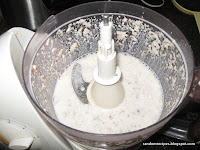Crunchy egg and cabbage flan
Serves 4-5
Ingredients:
Base:
100g breadcrumbs
100g wholewheat flour
100g oats
30g flaxseeds
150g butter or spread, melted
Topping:
3 tblsp olive oil
1 large onion, finely chopped
200-300g cabbage, shredded
200g mushrooms, sliced
salt and pepper
50g butter or spread
4 eggs
Method:
Heat oven to 190C (375F).
Mix the dry ingredients for the base together in a bowl, and stir in the melted fat. Mix to combine, then press into a greased flan dish (pyrex, ceramic or metal), around 25-28cm in diameter. Press down well using the back of a large spoon, or a potato masher, then bake in the hot oven for about 15 minutes. Cool slightly.
To make the filling, soften the onions in the oil in a deep pan over a medium heat, then add the shredded cabbage and stirfry until it is hot but still crunchy. Add the mushrooms, and season with salt and pepper to taste, then place a lid on the pan and keep warm.
Melt the remaining butter or spread in another pan and break the eggs in. Beat with a fork or wire whisk as if making scrambled eggs, then as they form solid curds tip into the vegetable mixture and stir quickly.
Pile into the cooked base, and serve hot, with other cooked vegetables and perhaps some baked potatoes, or cool and then chill, to serve cold with salad.
- - - - - - - - - - - - - - - - - - - - - - - - - - - - - - - - - - - - - - - -
I found this recipe in a book I bought, inexpensively, many years ago, called 'Vegetarian Cooking For Children' by Rosamond Richardson. After deciding to become vegetarian during Lent, I was looking for something a bit different from bean curries and lentil chilis, and came across a recipe called 'Elegant egg flan'.
by Rosamond Richardson. After deciding to become vegetarian during Lent, I was looking for something a bit different from bean curries and lentil chilis, and came across a recipe called 'Elegant egg flan'.
We thought the base - shown prior to cooking in this photo - was excellent, although I decided immediately to increase the amounts; the recipe in the book claimed to serve four, and to fit a 20cm flan dish, but I was not doing any potatoes so I used the amounts as shown here and it worked well.
The original recipe didn't have any onion, but I thought it needed some, so included that; I cooked the onion until it was just starting to go brown, but should have added the cabbage sooner, as it was still really quite crunchy. I was a bit dubious about the egg, but it worked well and made a meal that was decidedly different from anything I had made before, and just as good cold the following day as it was hot, served with some baked tomatoes and roasted carrots, and also some good dollops of home-made tomato ketchup.
Serves 4-5
Ingredients:
Base:
100g breadcrumbs
100g wholewheat flour
100g oats
30g flaxseeds
150g butter or spread, melted
Topping:
3 tblsp olive oil
1 large onion, finely chopped
200-300g cabbage, shredded
200g mushrooms, sliced
salt and pepper
50g butter or spread
4 eggs
Method:
Heat oven to 190C (375F).
Mix the dry ingredients for the base together in a bowl, and stir in the melted fat. Mix to combine, then press into a greased flan dish (pyrex, ceramic or metal), around 25-28cm in diameter. Press down well using the back of a large spoon, or a potato masher, then bake in the hot oven for about 15 minutes. Cool slightly.
To make the filling, soften the onions in the oil in a deep pan over a medium heat, then add the shredded cabbage and stirfry until it is hot but still crunchy. Add the mushrooms, and season with salt and pepper to taste, then place a lid on the pan and keep warm.
Melt the remaining butter or spread in another pan and break the eggs in. Beat with a fork or wire whisk as if making scrambled eggs, then as they form solid curds tip into the vegetable mixture and stir quickly.
Pile into the cooked base, and serve hot, with other cooked vegetables and perhaps some baked potatoes, or cool and then chill, to serve cold with salad.
- - - - - - - - - - - - - - - - - - - - - - - - - - - - - - - - - - - - - - - -
I found this recipe in a book I bought, inexpensively, many years ago, called 'Vegetarian Cooking For Children'
We thought the base - shown prior to cooking in this photo - was excellent, although I decided immediately to increase the amounts; the recipe in the book claimed to serve four, and to fit a 20cm flan dish, but I was not doing any potatoes so I used the amounts as shown here and it worked well.
The original recipe didn't have any onion, but I thought it needed some, so included that; I cooked the onion until it was just starting to go brown, but should have added the cabbage sooner, as it was still really quite crunchy. I was a bit dubious about the egg, but it worked well and made a meal that was decidedly different from anything I had made before, and just as good cold the following day as it was hot, served with some baked tomatoes and roasted carrots, and also some good dollops of home-made tomato ketchup.









